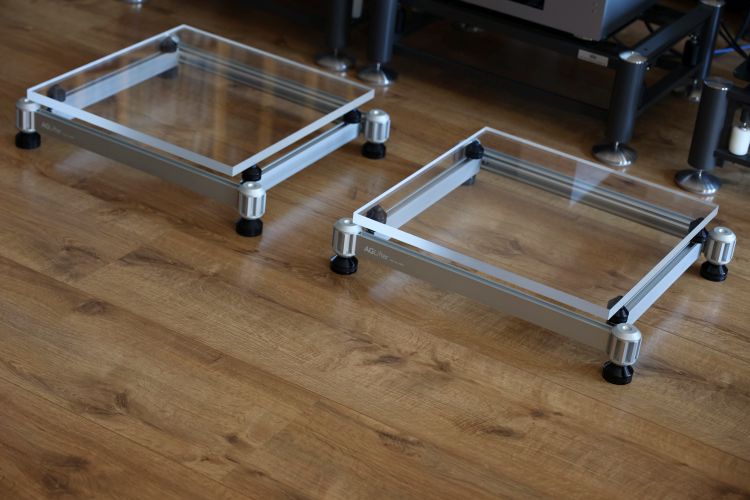
Review Context
The Stands were listened to in the main system that consists of the CH Precision C1.2 DAC, CH Precision L1 preamplifier and CH Precision A1.5 power amp, with Magico S1 MkII speakers. Digital sources include the Aqua La Diva M2 CD transport and the Grimm MU1 and Antipodes K50 Music Servers, both running Roon. As a final touch, I will also include the Accuphase E-270 Integrated Amplifier. Racks and platforms for comparison include the Artesania Exoteryc, Artesania Aire Platform, Organic Line Modular Rack/Platform, and Finite Elemente Spider.
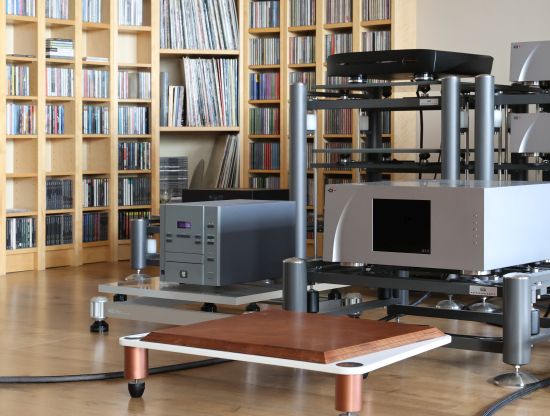
How to judge the influence of a rack?
How do you judge the quality of an audio rack? While we can all agree on the importance of sturdy support, not adding coloration, and controlling resonances, it seems impossible for a reviewer to issue an absolute qualification for any platform or rack. With the techniques of coupling, decoupling, damping, and earthing, wide-ranging results can be obtained. Given that all materials and material combinations have their specific sonic properties that can result in a certain character that is added to or sometimes subtracted from the music, the question becomes, what exactly is neutral?
Even that seemingly simple question is hard to answer because it depends on what you are comparing it to. Would we consider the floor to be a neutral starting point? Or do we accept a “mediate” level of coloration from a typical piece of furniture (if we even know what is typical) and set that as the baseline? Ultimately, it’s all relative and honestly quite subjective.
As I use Artesania Exoteryc Racks and both Aire and Organic Line Modular Platforms, naturally, I will compare the AG Lifter Racks and Stands with these so that we obtain a relative assessment. To make for an even more varied landscape against which to judge the AG Lifter qualities, I was able to loan from a friend an old favorite, the then-revolutionary Finite Elemente Spider Rack.
Although I depend on the Artesania racks and platforms for most of my reviews, these products are also not entirely transparent or free of character. Then, of course, one can ask if that is even the objective. Under ideal circumstances, I would say this is indeed what to strive for. But there are many factors that can influence this theoretical ideal and make it desirable to deviate from it. For instance, room acoustics, floor construction, system synergy, and personal preferences.
As such, my goal with this review will be to use a range of audio components on top of the AG Lifter products and describe how they affect the sound, in comparison to the aforementioned other racks and platforms so that we obtain a detailed relative assessment.
Listening Round 1 – Servers
Although the Crescendo Power Amp Stand is primarily intended for amplifiers, it can be used for any equipment that needs a solitary support system, thanks to the swappable bearings. To start off nice and easy, I selected the very lightweight Grimm MU1 as the first test subject. For this part of the review, I will also use the main CH Precision audio system as described in the Review Context section.
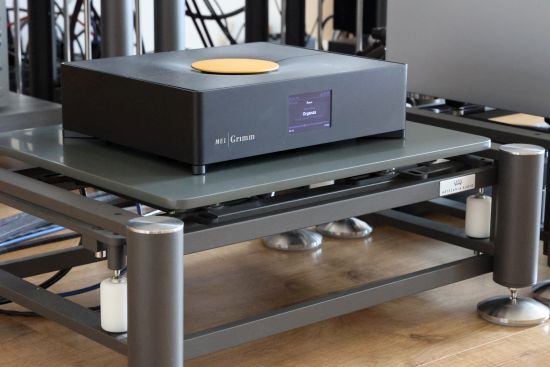
In my day-to-day use, the MU1 is placed on an Artesania KSH2 Krion shelf that sits on Carbon Linear Arms mounted on top of an Artesania Aire Platform. For such a lightweight and undamped product as the MU1, the expectation may be that it may be more susceptible to resonances than very heavy products, but on the other hand, common sense dictates that a purely digital device should not be subject to such considerations. Well, on that topic I can be very short, as I found that literally all components respond to the surface onto which they are placed. This includes servers and streamers as well as amplifiers, power distributors, and even network switches. Oh, and I might add that weight has very little to do with it, either. Even the 50kg heavy Taiko Audio Extreme Music Server responds very clearly to what it is placed on and the same goes for any of my CH Precision components and even a monster amplifier such as the Bryston 14B 3 (Cubed). In short, solid build quality is great but it does not make an audio component immune to vibrations or other external influences.
Some listeners may find the Grimm MU1 to sound a little lean, clean, or matter-of-fact, and when judged against the landscape of the average Music Servers that are currently available, I understand that sentiment. In the context of my system, however, it sounds neutral and rather well-balanced, if not as liquid, lush, and organic as the Taiko and Antipodes servers. With the Artesania KSH2 Krion shelf, I have chosen to accentuate the server’s strong assets which are its tightness, speed, and transient behavior, and the shelf does not do the server any favors in terms of lushness, body, or tonal fulness.
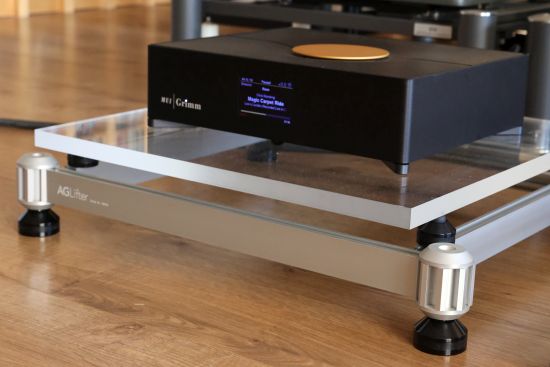
Moving the Grimm from the Artesania platform to the Crescendo Power Amp Stand (fitted with standard Dulcet 20 Feet and rubber ball interfaces) makes a surprisingly large difference. Yup, this is “just” a server with an AES/EBU output but the change in sonic perspective is undeniable, and rather easy to hear. The sound went from very crisp, tight, expressive, and relatively cool and lean to considerably fuller and weightier, and more relaxed, with bigger bass, a smoother and warmer midrange, and an overall more free-flowing, and considerably more liquid presentation. As a friend commented, this was a much more pleasant sound, and it is easy to sink into.
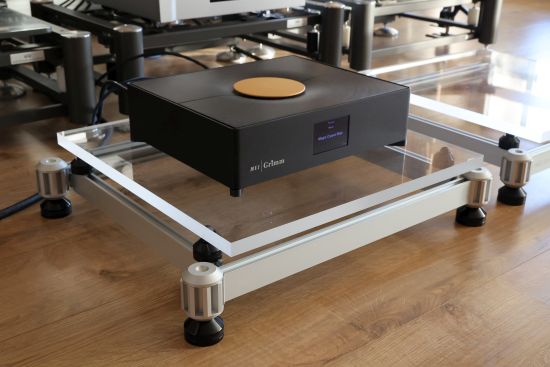
The level of resolution and overall precision are maintained, and the Crescendo beautifully refrains from imposing any character onto the sound. However, the platform does make the articulation less distinct and transient attack less immediate, and as a result, there is a lower overall level of analytical expression. If one’s objective is to make the Grimm sound richer and more full-bodied and arguably more toward what’s expected from inherently lusher and more organic servers such as those by Antipodes, then the Crescendo’s contribution can be considered a very successful change. But if one seeks the ultimate in analytical performance (warts and all), then the Artesania combination makes a better proposition. As such, the two rack solutions propose almost opposing presentations.
In all fairness, while for the most part, the Aire + KSH2 Krion shelf pairing refrains from adding a sonic signature, the Aire itself does slightly diminish the bass fullness and punch in the upper bass and lower midrange (which I rather had it did not do). The KSH2 Krion shelf that I use on top adds clarity and expression in the midrange but adds nothing in terms of saturation, body, or fullness. And this is where the AG Lifter Crescendo has a fabulously positive influence as it certainly does not lack any energy or substance in these areas.
Bearing Swap
In line with the AG recommendation, I used the rubber bearings between Dulcet 19 feet and the Acrylic platform for the MU1, but I wondered what would happen if I used the steel bearings instead. The swap was easily made, and indeed, the sound did change rather noticeably.
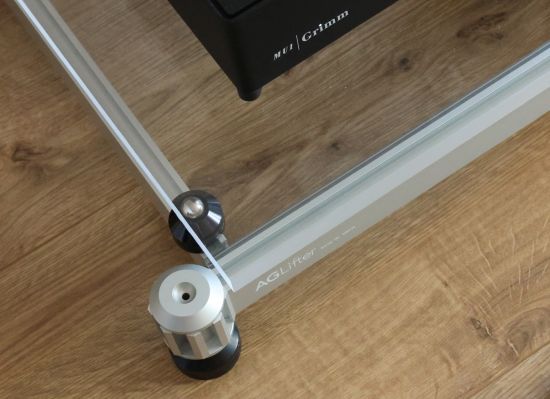
Now on steel bearings, the sound is considerably more articulate and direct, but in all fairness, with reduced musicality due to a good portion of the platform’s inherent smoothness and free-flowing qualities being reduced. The extra articulation and expression were nice, but on an emotional level, and on balance, I much preferred the sound with the rubber bearings. So, whether coincidence or not, the bearing recommendation, in this case, proves spot-on. So, the rubber bearings remained for the rest of the test.
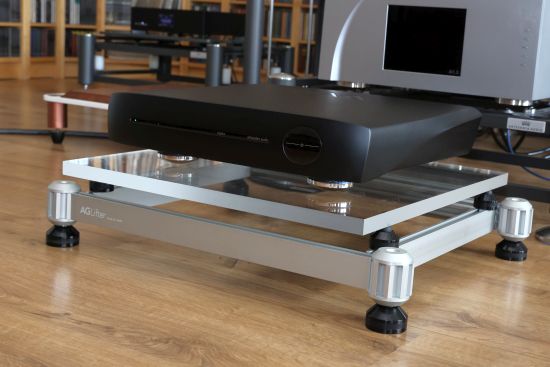
Switching to the Antipodes Oladra server, the relative differences turn out very similar as with the Grimm, although the Oladra’s inherently smoother and more relaxed starting position does emphasize the end result. Basically, no matter how you support an Antipodes server, it will always sound full-bodied, free-flowing, and organic, and this is one of their alluring qualities. What you can do is either try and pull it more toward the tighter and more analytical side or emphasize its naturally smooth character, and the AG Lifter Crescendo blissfully achieves the latter.
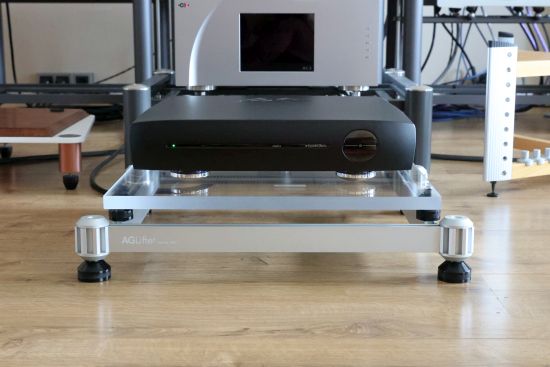
The Crescendo platform maximizes the Oladra’s natural tendencies by making it sound even richer, creamier, and lusher. It’s a positively luxurious sound that is rather seductive with soulful music and it is the absolute opposite of gray, lean, dry, or threadbare.
Now, let’s move on to the platform’s intended purpose, which is to serve as an amplifier stand.
Next: Listening Round 2 – Amplifiers


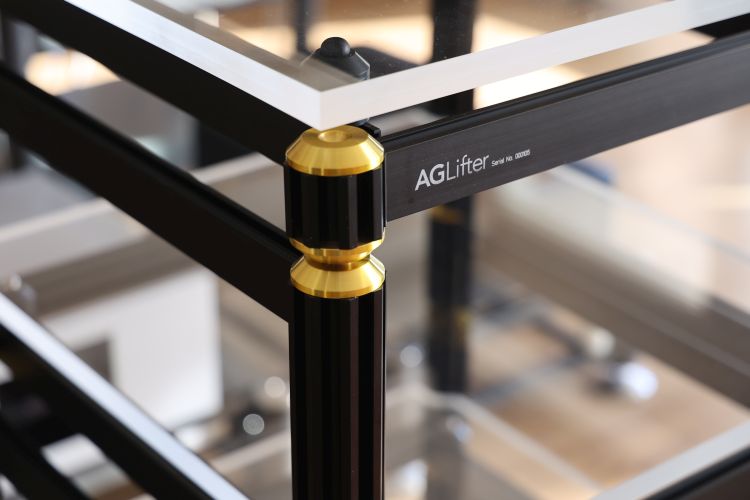
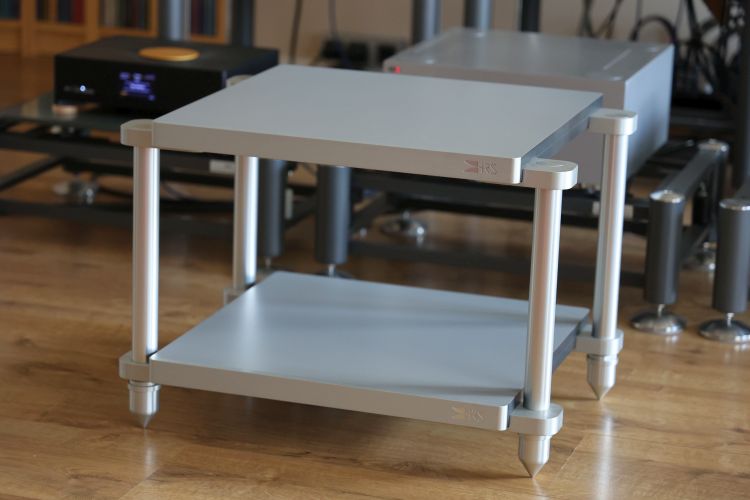
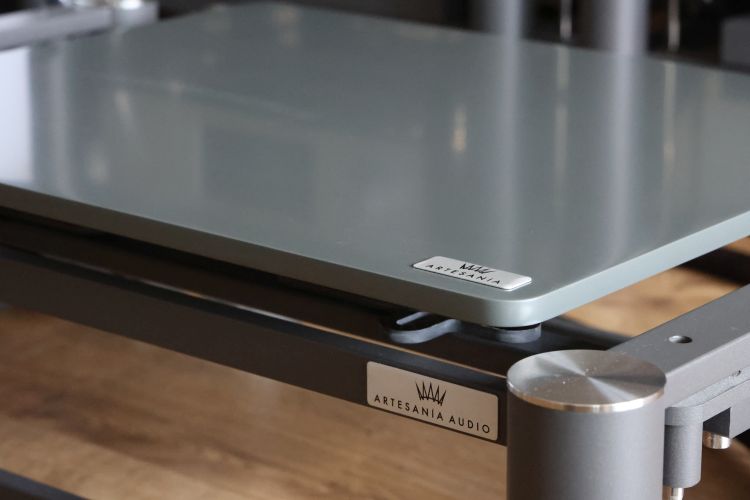
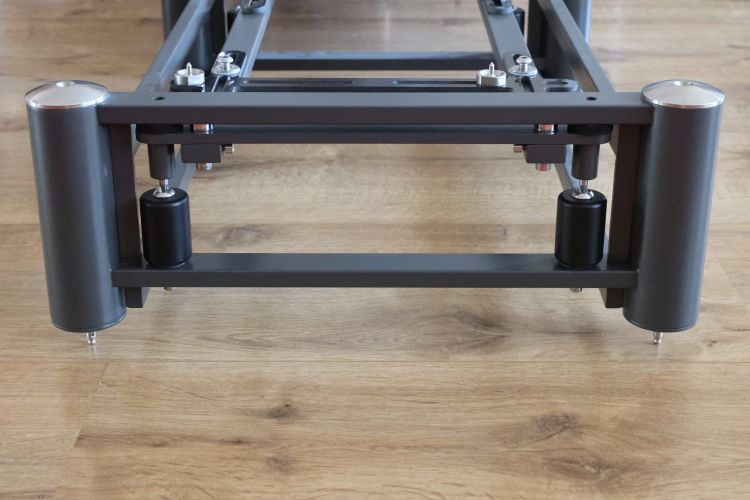
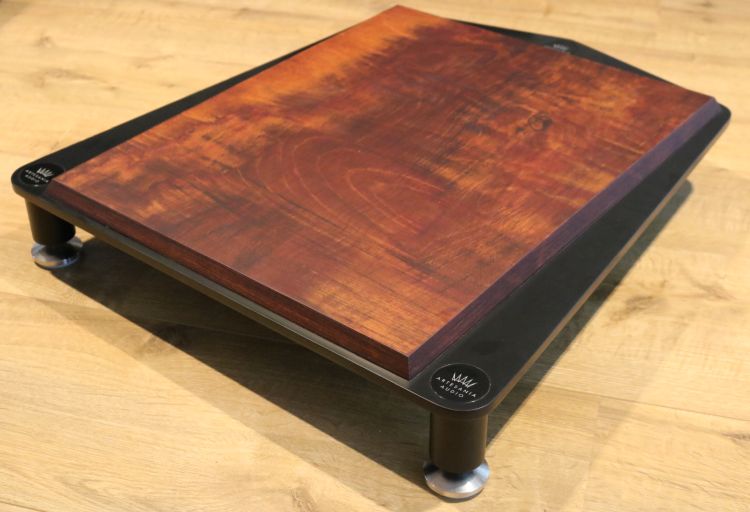
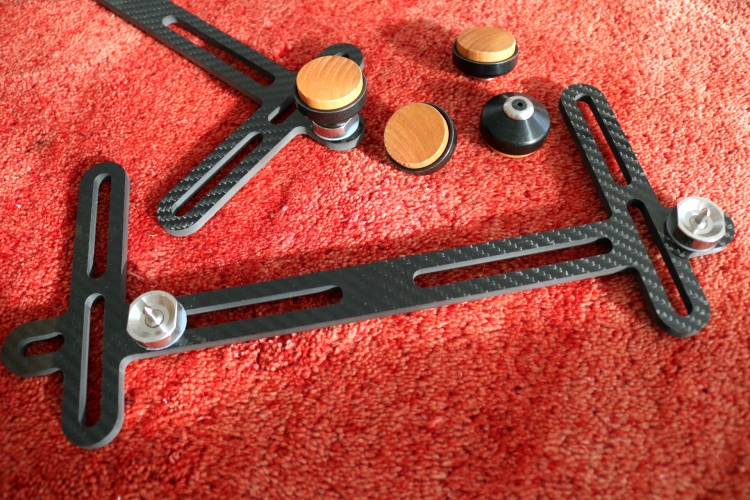
$5k for acrylic ?
Madness !